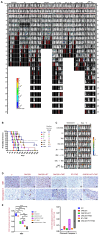Imipridones ONC201/ONC206 + RT/TMZ triple (IRT) therapy reduces intracranial tumor burden, prolongs survival in orthotopic IDH-WT GBM mouse model, and suppresses MGMT
- PMID: 40145650
- PMCID: PMC11948724
- DOI: 10.18632/oncotarget.28707
Imipridones ONC201/ONC206 + RT/TMZ triple (IRT) therapy reduces intracranial tumor burden, prolongs survival in orthotopic IDH-WT GBM mouse model, and suppresses MGMT
Abstract
Glioblastoma remains a lethal brain tumor in adults with limited therapeutic options. TIC10/ONC201, a first-in-class imipridone we discovered, achieved meaningful therapeutic effects in phase I/II trials in patients with diffuse gliomas (DG's) harboring H3K27M mutations, and currently the drug is in randomized phase III testing (ACTION trial; NCT05580562). ONC201 targets mitochondrial protease ClpP to disrupt oxidative phosphorylation and trigger the integrated stress response (ISR), TRAIL/DR5, and tumor cell death. While ONC201 and its analog ONC206 are undergoing clinical trials as single agents, there is limited information on their interactions with stand-of-care therapy. We show that ONC201 and ONC206 synergize with temozolomide (TMZ) and Radiotherapy (RT). ONC201 enhances TMZ- or RT-induced apoptosis, ISR and cytotoxicity. ClpP-silencing suppresses ONC201-induced cytotoxicity but not TMZ. Both ONC201 and ONC206 reduce expression of TMZ-resistance mediator MGMT observed in H3K27M-mutated DG cells following treatment with imipridones+TMZ. Cytokine profiling indicates distinct effects of ONC201 relative to TMZ treatment. These results suggest mechanisms underlying ONC201's anti-tumoral activity are distinct from those associated with TMZ or RT with potential for synergy between these three treatments. Triple ONC201+RT+TMZ (IRT) therapy prolonged median survival to 123 days with tail on survival curve (3-of-7 mice alive beyond 200-days) in orthotopic U251 GBM model versus ONC201 (44-days; p = 0.000197), RT (63-days; p = 0.0012), TMZ (78-days; p = 0.0354), ONC201+RT (55-days; p = 0.0004), ONC201+TMZ (80-days; p = 0.0041) and RT+TMZ (103-days; p > 0.05). By 231-days, the only surviving mice were in IRT group. Our results support investigation of ONC201/ONC206 in combination with RT/TMZ (IRT) in GBM or H3K27M mutated DG therapy.
Keywords: IDH; MGMT; ONC201; ONC206; glioblastoma multiforme; radiotherapy; temozolomide.
Conflict of interest statement
W.S.E-D. is a co-founder of Oncoceutics, Inc., a subsidiary of Chimerix. Dr. El-Deiry has disclosed his relationship with Oncoceutics/Chimerix and potential conflict of interest to his academic institution/employer and is fully compliant with NIH and institutional policy that is managing this potential conflict of interest.
Figures








Similar articles
-
Riluzole enhances the antitumor effects of temozolomide via suppression of MGMT expression in glioblastoma.J Neurosurg. 2020 Mar 13;134(3):701-710. doi: 10.3171/2019.12.JNS192682. Print 2021 Mar 1. J Neurosurg. 2020. PMID: 32168477
-
Inhibition of GSH synthesis potentiates temozolomide-induced bystander effect in glioblastoma.Cancer Lett. 2013 Apr 30;331(1):68-75. doi: 10.1016/j.canlet.2012.12.005. Epub 2012 Dec 12. Cancer Lett. 2013. PMID: 23246370
-
Alkylpurine-DNA-N-glycosylase confers resistance to temozolomide in xenograft models of glioblastoma multiforme and is associated with poor survival in patients.J Clin Invest. 2012 Jan;122(1):253-66. doi: 10.1172/JCI59334. Epub 2011 Dec 12. J Clin Invest. 2012. PMID: 22156195 Free PMC article.
-
Glioblastoma in the elderly.Cancer Treat Res. 2015;163:159-70. doi: 10.1007/978-3-319-12048-5_10. Cancer Treat Res. 2015. PMID: 25468231 Review.
-
Combination therapy of supercharged NK cells and ONC201 or ONC206 to target aggressive K27M brain tumor.Crit Rev Immunol. 2025;45(3):0. doi: 10.1615/CritRevImmunol.2025058345. Crit Rev Immunol. 2025. PMID: 40460384 Review.
References
MeSH terms
Substances
LinkOut - more resources
Full Text Sources
Medical
Research Materials

